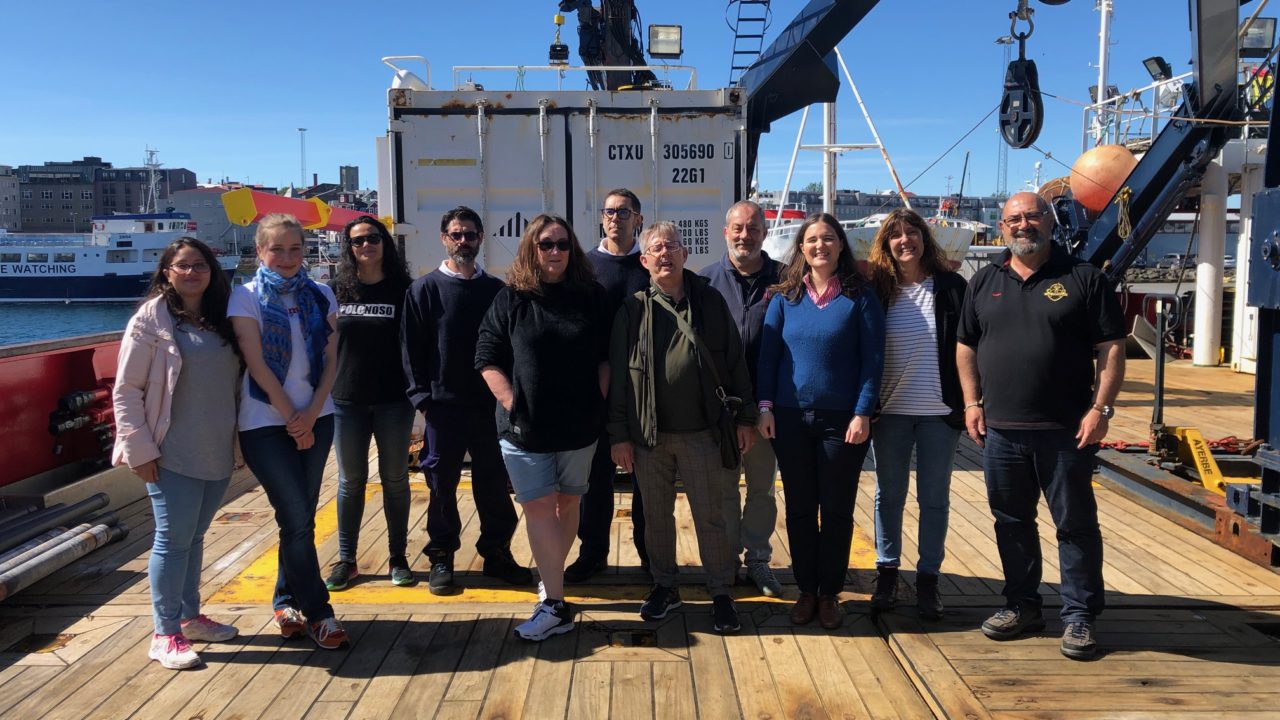This Wednesday a team of researchers from the Marine Research Center of the University of Vigo departed from Reykjavik on board the Sarmiento de Gamboa to start the first oceanographic campaign of the BOCATS2 project (Biennial observation of carbon, acidification, transport and sedimentation in the North Atlantic). This study comprises two subprojects, one focused on the characterization of the water column (physical and chemical properties) and the other on the characterization of the sediments to interpret the properties and dynamics of the water masses in the past, which would involve the last tens of thousands of years. This second part is coordinated by CIM-UVigo researchers Guillermo Francés, from the Geological and Biogeochemical Oceanography Group, and Gabriel Rosón, from the Physical Oceanography Group. It supposes a continuation of a first study carried out in 2016 (BOCATS) and has as main objective “to continue with the observational monitoring (recent and past) of the ocean circulation and ocean acidification in the North Atlantic”. The information they will obtain is “essential to advance in the accurate detection of anthropogenic impact and to improve the projections of the adjusted climate models that underpin the IPCC reports for the North Atlantic subpolar gyre (SPNA), a region known for its strong influence on the European climate”, as Guillermo Francés highlights.
On board after six days in confinement
This expedition is no stranger to the special circumstances of the covid-19 pandemic. The scientific team, formed by UVigo researchers Irene Alejo, Marta Pérez Arlucea, Miguel Ángel Nombela and Guillermo Francés, the student of Marine Sciences Mª Fernanda Copete, the technician Susa Álvarez, a researcher of the ICM-CSIC of Barcelona and a student of the Royal Holloway University, were forced to carry out a 6-day quarantine upon arrival in Iceland before being able to board the Sarmiento de Gamboa. Finally, this Tuesday they were able to board the oceanographic vessel, which left Vigo on May 28th with another scientific team that developed, in these weeks, studies framed within another subproject of BOCATS2. After a day on board to prepare last minute issues, yesterday Wednesday the ship left the port of Reykjavik.
And as Guillermo Francés explains, the study coordinated by the CIM is part of a larger project, coordinated by the Institute of Marine Research (IIM, CSIC), and funded with 342,430 euros, of which 124,630 correspond to the subproject of the University of Vigo, under the Generation of Knowledge 2019 program of the Ministry of Science and Innovation. The overall objective is to study the millennial and submillennial variability of deep currents through the channels that cross the Reykjanes Ridge (Bight and Charlie-Gibbs fracture zones), southwest of Iceland. These two fracture zones, especially the CGFZ, constitute the main deepwater communication routes between the western and eastern North Atlantic basins, and their hydrography is rather unknown, both at present and in the past when they were under other global climatic conditions. BOCATS2 also intends to continue with the estimation of carbonate and organic carbon flux to sediments, along the lines of the preceding project, essential aspects related to the production, accumulation and preservation of these compounds (carbon cycling, acidification, etc.).
Towards the Bight Fracture Zone
The team aboard the Sarmiento de Gamboa will focus its work on the Bight Fracture Zone, a large transforming ridge that cuts the Reykjanes Ridge and is one of the main pathways for deep water masses between the eastern and western basins of the North Atlantic”. The other ond, he adds, “is the Charlie-Gibbs Fracture Zone”. The scientific plan for the coming weeks comprises two phases. On the one hand, “the acoustic characterization of the seabed with multi-beam and parametric echo sounders in order to obtain a detailed mapping, the internal structure of the first meters of the sedimentary filling, and the most suitable choice of the sampling points”. The second part of the work will consist of obtaining surface sediment samples using a box- corer type dredge”, to then carry out “the sedimentary registry by means of gravity sieve sampling”. Both operations will be carried out at four different points along the fracture zone, “two to the west of the ridge and two to the east”.
The team will return to the port of Vigo in mid-July, but this oceanographic campaign will be followed by a second one in 2023, which will complete the project.
Fonte: DUVI




